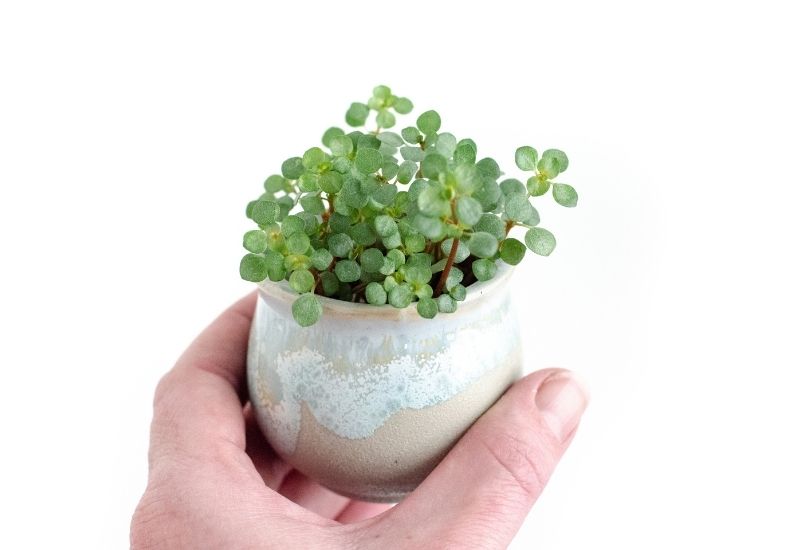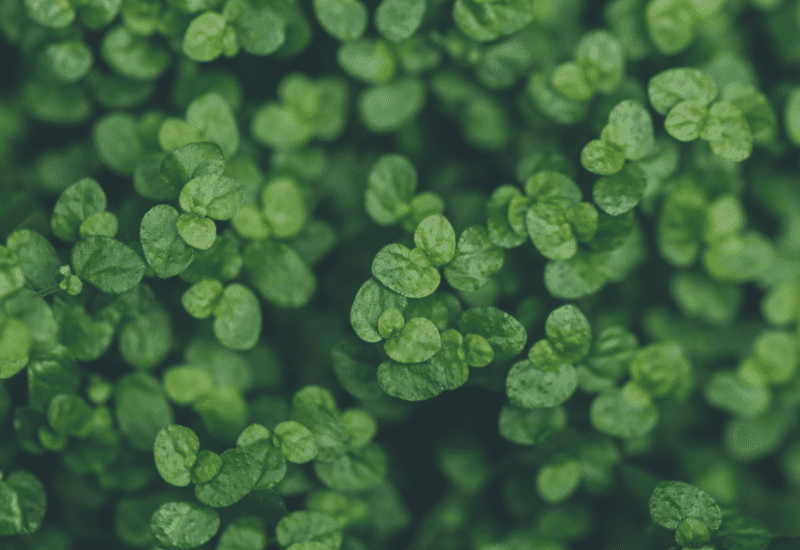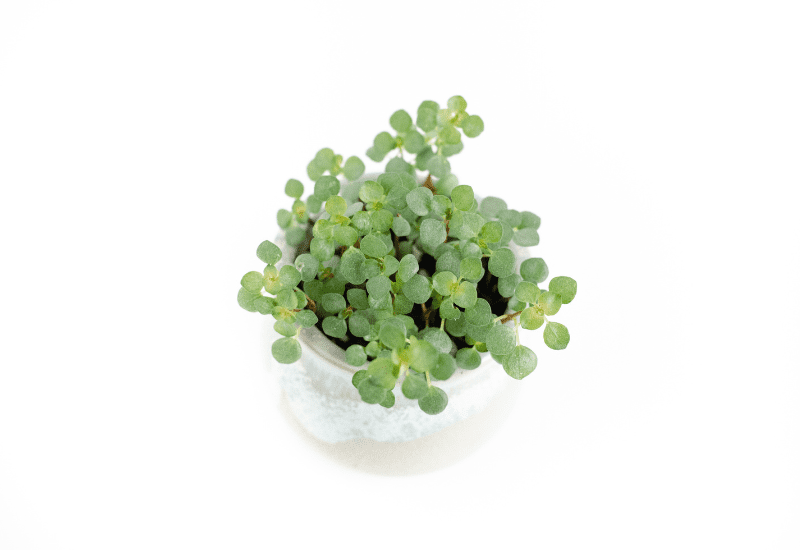Pilea Glauca is a tropical houseplant rising in popularity with good reason. Its beautiful bundles of tiny, silver-tinged leaves trail fetchingly from a hanging basket or plant stand. With little day-to-day maintenance needed, it’s a plant that even novice gardeners can grow successfully. Let’s find out more about this serene charmer with mysterious beginnings.
Pilea Glauca Care Guide Overview
- How To Plant (when & where)
- How To Grow (staking, watering, fertilizing, humidity, mulching)
- How To Trim And Prune
- How To Pot And Repot
- How To Propagate (when & how)
- And Pests and Diseases, Plant Species, Companions, Toxicity
Characteristics
- Scientific name: Possibly Pilea libanensis (to be determined)
- Common names: Pilea Glauca, Silver Sparkle Pilea, Grey Artillery Plant, Grey Baby Tears, Red-Stemmed Pilea
- Origin: Mt. Libanon near Guantanamo, Cuba (if confirmed to be Pilea libanensis); otherwise, possibly Central America or the Brazilian rainforest
- Indoor/Outdoor Plant: Indoor houseplant or terrarium plant; outdoor containerized annual; tropical outdoor ground cover
- Height and Structure: As a houseplant, about 12 to 36 inches tall with a cascading habit. Terrarium plants are usually kept smaller
- Temperature: Typical indoor temperatures. Not frost tolerant, but can adapt to cooler temperatures (50-60 degrees F)
- Flower color: White, pink, or peach, but small and inconspicuous
The “Just Right” Indoor Environment

Temperature and Spacing
Pilea Glauca is a “Goldilocks” type of plant–it doesn’t care for extremes. It is comfortable in an environment where people are comfortable. It can be introduced whenever indoor temperatures are moderately warm. Also, this plant is not fussy about spacing. If you intend to let it grow to be quite large, give it plenty of room. If you are looking for a bushier appearance, you can put multiple plants in a single pot.
Soil
The soil mixture should be light and able to drain well, such as a succulent mixture with perlite in about a three to one ratio. Pilea Glauca is not particularly fussy in this regard, and many commercial mixtures will work just fine as long as they don’t become compacted and are given the opportunity to become nearly dry between waterings. Peat moss or organic matter are valuable additions to a commercial mixture.
Light
Light is an important consideration for Pilea Glauca. It does well with several hours of indirect (filtered) sunlight per day, perhaps near a bright but curtained window. Beware of placing your plant in direct sunlight–it may scorch the leaves. If your plant has a leggy appearance or its leaves are sparse, move it to a location with greater exposure to indirect light.
Humidity
Humidity should not be an issue for an indoor Pilea Glauca except perhaps in winter when indoor heating systems are running frequently. You may want to consider the use of a humidifier if your plant’s leaves have a crispy appearance. Grouping several houseplants together is another easy strategy for increasing humidity for them all.
Routine Care for your Pilea Glauca

Pilea Glauca is a low-maintenance plant, but it does not thrive on neglect. It needs regular, but simple, care.
Watering
The first consideration is watering. Distilled or purified water brought to room temperature is appreciated by Pileas–it does not care for chlorination. The soil should be kept slightly moist. After the soil has dried out to a depth of 50-80% of the pot’s depth, it can be watered again. Water generously so that the excess runs out the drainage holes, then drain the saucer. Don’t allow the soil to dry out completely, but also beware of overwatering. The roots are susceptible to rot if left in standing water, so be sure your plant is not sitting in a saucer filled with water! A watering cadence of once a week should be about right during warm months. Pilea Glauca needs to be watered less frequently if kept in a cool location during the winter, approximately every two to three weeks.
Observe your plant to help guide you in your watering practice. Overwatering can cause brown spots on leaves, or drooping leaves that curl downward. Underwatering will often be marked by crispy or puckered leaves that may fall off. You might also want to consider watering from the bottom. When Pilea Glauca is watered from the top, droplets left on the tiny leaves may cause them to rot. You can water from the bottom by sitting the pot in a container of water and allowing it to soak up the water until the soil feels moist. Then give the pot a few minutes to drain in your sink before replacing it in its saucer.
Fertilizer
Pilea Glauca should be fertilized during warm months but you don’t need to fertilize during the cool winter. Use a balanced NPK (Nitrogen, Phosphorous, Potassium) mixture such as 5/5/5 or 10/10/10. Apply when the soil is already moist and use a mixture diluted to half the strength of what the label directions indicate. This will prevent the plant’s roots from sudden contact with chemicals which may burn them. Using a liquid fertilizer monthly during warm weather should be sufficient. Pilea Glauca also does well with long-acting fertilizer spikes or granules used during the spring and summer.
Pruning
To keep your plant in a pleasing shape and looking its best, some minor pruning may be needed occasionally. Don’t remove more than 20% of the plant at one time. If you intend to cut back your plant more drastically than that, proceed in stages with a few weeks recovery time in between prunings. Using scissors or pruning shears cleaned with isopropyl alcohol, clip the leaf stem back to the main stem. As an older plant may come to have a tangled or leggy look, thoughtful pruning can give your Pilea Glauca a greatly improved appearance. Also, don’t hesitate to just pinch a little growth off your plant here and there to help it attain a more full appearance.
Repotting

Repotting is rarely needed with Pilea Glauca. Many gardeners prefer to keep a smaller size plant, and the root system is not extensive. For a newly purchased plant, do not repot for at least one year to give the plant plenty of time to become acclimated to the new environment. It is best to tackle repotting in the springtime, and to increase the size of the pot gradually over your plant’s lifetime. Simply remove the plant from the smaller pot, allowing some soil to be transferred to the larger pot. Fill around the roots with a fresh, similar potting mixture. After repotting, you should not need to do so again for several years.
Pilea Glauca Propagation
Another ingredient in Pilea Glauca’s popularity is that it is very easy to propagate new plants from an existing one. Take small stem and leaf cuttings that are one-half inch or greater in length. Lay them on top of the potting mixture in a prepared pot, and press gently so that there is good contact. Keep the soil moist but not wet. You may cover the pot with a plastic bag to increase humidity, but remove the bag for part of each day to prevent the growth of mold.
While propagating in soil is the recommended method, you can also propagate cuttings in purified (dechlorinated) water. Change the water every few days, and keep the leaves dry. Once the roots are about an inch long, transfer the seedling to the planting medium. The drawback to this method is that all of the fragile roots may not survive the transfer to soil.
The easiest method of all is that the Pilea Glauca may self-propagate. You may find miniature plants growing in the soil alongside your main plant. They can be left in place for a bushier look, or gently detached with scissors and placed in their own pots.
Pests and Diseases
Pests
Pilea Glauca is susceptible to the pests that typically invade house plants such as aphids, spider mites, or mealybugs. They may be eradicated by spraying the plant with a mixture of 1 part isopropyl alcohol to 4 parts water. You might also try an insecticidal soap. The best protection against pests is to monitor your plants so that you spot an infestation before it is widespread. Keeping your plants healthy will help them mount their own natural defenses more successfully.
Diseases
Disease risk in this plant is greatly associated with too much moisture. Root rot is the chief concern. Excessive moisture can also lead to leaf-spot disease, botrytis, or powdery mildew. If you suspect these issues, revisit your watering schedule, and try reducing the frequency of watering. Also, if you have not tried watering from the bottom, this would be a good time to do so. Above all, don’t give up! Even a plant with a single leaf left on it can often be rehabilitated by getting back to basics with proper soil, lighting, and moisture.
Toxicity
If your household includes small children or pets, Pilea Glauca may be an especially good choice for your indoor garden. They are not toxic to humans or animals.
Other Plants Related to Pilea Glauca
Pilea Glauca is part of the Urticaceae family, sometimes known as the nettle family. More than 700 species are members of this family. Some, like Pilea Glauca, still lack a proper botanical identification. One well-known cousin is Pilea Peperomioides, also known as a Chinese Money Plant. Other relatives include Pilea Cadierei (Aluminum Plant) and Pilea Spruceana (Silver Tree).
Companion Plants for Pilea Glauca
Because Pilea Glauca thrives with moderate temperature, humidity, moisture, and indirect light, it makes a great neighbor for many houseplants that also dislike extremes. For example, many orchids would thrive in similar conditions. The large glossy leaves of an orchid make a striking contrast with the tiny, silver-tinged leaves of the Pilea. Another possible choice to grow alongside a Pilea is a succulent that thrives in indirect light such as a snake plant, with its striking sword-like leaves. A holiday-blooming cacti would also do well in the lighting conditions and temperature range favored by Pilea Glauca.
Bear in mind, Pilea Glauca can also be used in a terrarium, and will grow well under artificial light. Because it doesn’t mind crowding, it could be snuggled up against companion plants such as polka-dot plant, golden pothos, or peperomia. All need relatively little watering and are fine with indirect lighting. You can fashion a terrarium grouping that is pleasing to your eye and easy to maintain with just a bit of effort and imagination.
In Conclusion
Don’t let the idea that botanists have not yet officially identified the Pilea Glauca and its origins deter you from growing this charming and versatile houseplant. It requires little regular maintenance or fuss. With just a bit of attention to light, water, and temperature conditions, you will have a beautiful and interesting plant to enjoy for years to come.


